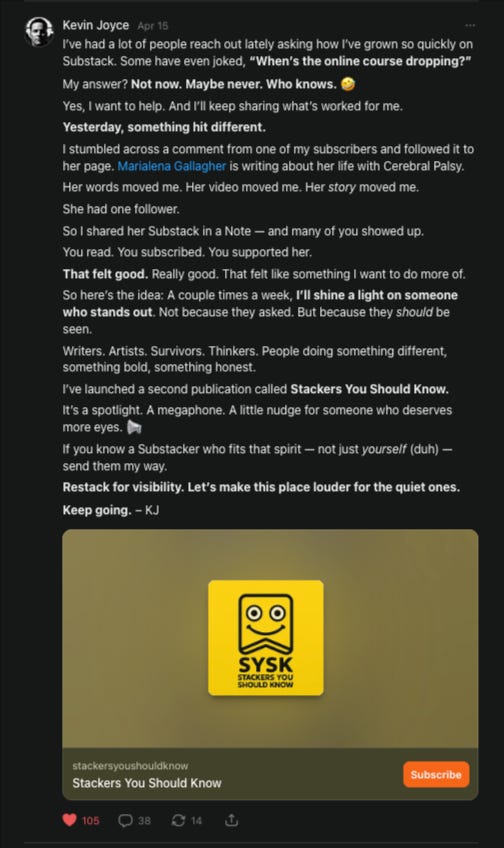Why Your Substack Notes Aren’t Working (And How to Fix Them in Seconds)
There's a marketing psychology that makes smart ideas spread like wildfire. Here's how to master it—fast.
You’ve seen them.
📝 Substack notes that rack up hundreds of likes, re-stacks, and comments.
📈 Mini-stories that spread like wildfire across Substack.
🚀 Observations so magnetic, you click “subscribe” without even thinking twice.
And then you post something just as smart—maybe even smarter—and it goes… nowhere.
Crickets. Nada. Ghost town.
So what gives?
Let me break it to you gently:
It’s not the idea.
It’s not the platform.
It’s the packaging.
The difference between forgettable and viral comes down to one thing:
Marketing Psychology.
Wait—don’t run.
This isn’t a textbook lecture.
I’ll show you what I mean in under 60 seconds.
Let’s look at three real Notes:
See if you can spot the differences between them.
Note 1
Kevin Joyce: 105 Likes, 38 Comments, 14 Restacks
Note 2
Zalman Nelson: 49 Likes, 75 Comments, 1 Restack
Note 3
Honest Embellishments: 2 Likes, 2 Comments, 0 Restacks
🧠 The Psychology Behind What Works (and What Doesn’t)
First, I’m not knocking any of these writers. They all create great stuff, so definitely go check all three of them out. This is just an analysis of what separates the notes that perform from the ones that don’t – and how you can replicate the ones that do.
Let’s decode what really happened under the hood:
🟢 Kevin’s Note
It hits something called the “P-A-S” framework hard:
Problem: Undiscovered talent
Agitation: “She had one follower”
Solution: A spotlight publication and a CTA to uplift others
It triggers the Endowment Effect, Social Proof, and a Framing Shift—positioning readers not just as spectators, but as participants. It communicated in a way that causes the reader to feel something.
🟡 Zalman’s Note
It has the right energy, but lacks a narrative arc. It’s supportive, not sticky. There’s no clear journey or emotional payoff to anchor readers. With a “S.L.A.Y.” structure, it could’ve soared:
Snap: Snap attention with a bold or emotional opening
Lead: Lead with a relatable story or vivid example
Add: Add authority, experience, or a surprising insight
Yank: Yank the audience into action with a specific, clear CTA
Without these elements, the Note feels helpful but forgettable—good for comments, but weak for virality.
🔴 Honest Embellishments
This note fizzled because it lacked emotional tension, a vivid example, and a compelling CTA. The idea was there—but it wasn’t framed or contrasted for virality.
Here’s an example of how it could’ve been framed to improve engagement using the S.L.A.Y structure:
What’s the Substack Canon? It’s real—and it’s waiting for us to name it.
The essays that cracked something open inside you.
The poems you still think about years later.
The posts that made you whisper: 'I wish I could write like this.’🔍 Lets’ build a living archive—a hall of fame for the words that stayed.
A place where the best of Substack never gets lost.Drop your all-time favorites below—or nominate your own.
✍️ Let’s build the Canon together.
Why This Version Works:
Snap: Opens with a bold question and subsequent claim that sparks recognition and curiosity.
Lead: Anchors in shared experience ("cracked something open inside you").
Add: Frames the request with a purpose (“let’s build an archive”) which signals meaning.
Yank: CTA is direct, inclusive, and identity-based (“nominate your own” = share proudly).
The Problem With These Frameworks
🔁 These are more than just “performance stats.” I could break down a thousand other notes and posts. They’re proof that packaging—psychology + structure—is what turns smart Notes into scroll-stopping stories.
But here’s the problem...
It can take years of practice to spot these patterns.
Years to master storytelling formats like SLAY, PAS, AIDA, and others.
Years to intuitively use tactics like the Framing Effect, IKEA Bias, or Rule of 3.
And to actually grow on Substack?
Recent data from top-performing publications suggests you should post 3–5 Notes per day to stay top of mind.
That’s:
90–150 Notes per month; 1,800+ per year
And no realistic way to keep up—without help.
Even experienced marketers can’t hit that cadence and quality consistently.
That’s Why I Created VTG – The Viral Thread Generator
(Yes, I know “thread” sounds X-ish. But bear with me—this applies beautifully to Substack Notes and Posts.)
VTG isn’t a writing tool. It’s a thinking machine.
It takes any short story, personal anecdote, lesson, or insight—and turns it into a viral Note, optimized for:
✅ Substack
✅ LinkedIn
✅ Threads
✅ X (formerly Twitter)
✅ Facebook
And it does this using:
✅ Time-tested frameworks like SLAY, PAS, AIDA, and BCG’s 4S model (Streaming, Scrolling, Searching, Shopping)
✅ Neuromarketing hacks like the Framing Effect, Contrast Bias, and the Power of 3
✅ Behavioral insights that reflect how your audience actually scrolls, pauses, and shares
Sound like a lot? That’s because it is.
But VTG teaches while it creates.
You don’t just get output—you learn why it works while you create.
The more you use it, the more your brain will start to recognize viral patterns in everyday moments. A walk, a podcast, a conversation at the coffee shop—all start to look like note-worthy insights.
You’ll start to think like a viral creator, even offline.
Why VTG Feels Different
🧠 It’s not a ghostwriter. It’s a mindset shift.
✍️ It adapts to your tone, not the other way around.
🎯 It boosts your consistency without sacrificing quality.
Most tools help you create more.
VTG helps you create smarter—and become more memorable in the process.
Final Thought
If you’re serious about growing your Substack—or building a personal brand that earns trust and attention—your biggest bottleneck is likely content velocity and clarity.
VTG removes both obstacles. It turns your loose thoughts into polished, story-driven Notes—without sounding like a robot or falling flat.
✅ Want to write better Notes in less time?
✅ Want to actually learn what makes content resonate?
👉 Get VTG at the Early Bird pricing now.
Get early access at early pricing + exclusive launch bonuses.
👀 Still not sure what’s holding your Notes back?
Try this: Take your last Note. Now apply 1 of these:
Add a micro-story arc
Frame it with a strong emotional contrast
Use a CTA that invites identity-based action
Did it change how it feels? That’s VTG thinking in action.
Let’s make your next 1,800 Notes your best yet.







